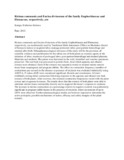| dc.description.abstract | Ricinus communis and Euclea divinorum of the family Euphorbiaceae and Ebenaceae, respectively, are
traditionally used by Traditional Birth Attendants (TBAs) in Machakos district of Kenya to induce or
augment labor, manage protracted labor, post-partum hemorrhage and retained after birth. Ethnopharmacological
relevance of the study will be the provision of scientific evidence and justification for
the ethnic use of both plants as oxytocic agents in the initiation of labor, treatment of prolonged labor,
post-partum hemorrhage and retained placenta.
Materials and methods: The plants were harvested in the wild, identified and voucher specimens
preserved. The root bark was processed to powder form, from which aqueous and ethanol extracts were
obtained. Each of the extracts was separately tested on isolated uterine muscle tissue from nonpregnant
and pregnant rabbits. The effect on contraction frequency (number of contractions
per second) in the absence or presence of oxytocin was evaluated statistically using ANOVA. P values
o0.05 were considered significant.
Results and conclusions: All uteri exhibited a strong initial contraction following exposure to the
aqueous and ethanol root bark extracts of both plants. After recovery, the resumed contraction
frequencies varied with the plant extract and exogenous hormone. The results show that the extracts of both plants were able to stimulate uterine tissue contractility directly and to augment the tissue’s response to oxytocin. The increase in uterine contractions as a percentage relative to negative controls was particularly significant in pregnant rabbit tissues in the presence of oxytocin, where increments of up to 245% were observed. Further pharmacological studies are however required to determine the
active principles, possible mechanisms of action, efficacy and safety margins of the plant extracts. | en |

